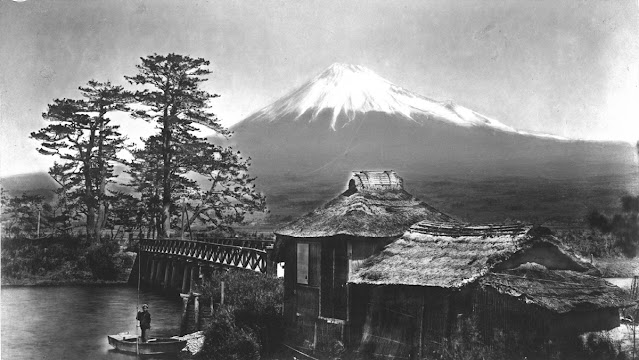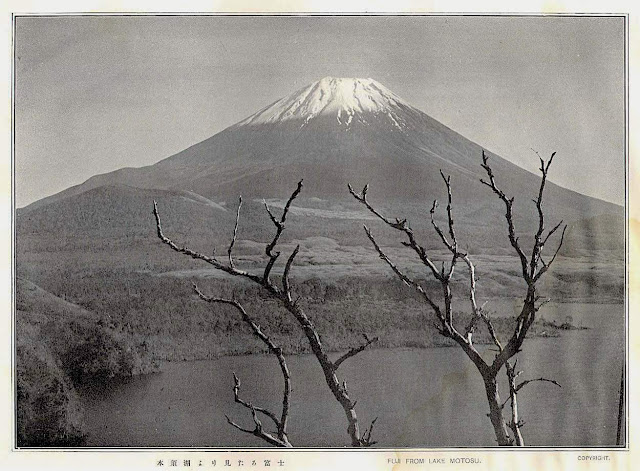%20Fujiyama,%201935%20%20Cardboard,%20tempera.%2030.8%20x%2046.1.jpg)
Fujiyama / 富士山 (3, 776 m -12,389 ft)
Japon
In Fujiyama, 1935 tempera. sur cartoN, 30.8 x 46.1cm, Galerie Tretiakov, Moscou.
La montagne
Le mont Fuji (3 776,24 m -12 389 pieds) ou Fujiyama (富士山) est situé sur l'île de Honshu. Il est le plus haut sommet montagneux du Japon. Plusieurs noms lui sont attribués : "Fuji-san", "Fujiyama" ou, de manière redondante, "Mt . Fujiyama". Habituellement, les locuteurs japonais appellent la montagne "Fuji-san". Les autres noms japonais du mont Fuji sont devenus obsolètes ou poétiques comme : Fuji-no-Yama (La montagne de Fuji), Fuji- no-Takane ( Le haut sommet du Fuji), Fuyō-hō (Le pic du Lotus) et Fugaku). Le mont Fuji est un stratovolcan actif dont la dernière éruption remonte à 1707-08. Le mont Fuji se trouve à environ 100 kilomètres (60 mi) au sud-ouest de Tokyo et peut être vu de là par temps clair.
Le cône exceptionnellement symétrique du mont Fuji, recouvert de neige plusieurs mois par an, est un symbole bien connu du Japon et il est fréquemment représenté dans l'art et les photographies, ainsi que visité par les touristes et les alpinistes.
Le mont Fuji est l'une des trois montagnes sacrées du Japon avec le mont Tate et le mont Haku. C'est aussi un endroit spécial de beauté scénique et l'un des sites historiques du Japon.
Il a été ajouté à la Liste du patrimoine mondial en tant que site culturel le 22 juin 2013. Selon l'UNESCO, le mont Fuji a "inspiré des artistes et des poètes et fait l'objet de pèlerinages depuis des siècles". L'UNESCO reconnaît 25 sites d'intérêt culturel dans la localité du mont Fuji. Ces 25 sites comprennent la montagne elle-même, le sanctuaire Fujisan Hongū Sengen et six autres sanctuaires Sengen, deux maisons d'hébergement, le lac Yamanaka, le lac Kawaguchi, les huit sources chaudes d'Oshino Hakkai, deux moules d'arbres de lave, les vestiges du culte Fuji-kō dans le la grotte Hitoana, les chutes Shiraito et la pinède Miho no Matsubara ; tandis que sur les basses Alpes du mont Fuji se trouve le complexe du temple Taisekiji, où se trouve le siège central du bouddhisme Nichiren Shoshu.
Le peintre
Né en Russie, Nicolas Roerich voyage autour du monde jusqu'à sa mort à Naggar dans la vallée de Koulou de l'Himachal Pradesh en Inde. Après des études de droit, il s'intéresse à la littérature, à la philosophie, à l'archéologie et tout spécialement à l'art. Il se forme à Paris auprès de Fernand Cormon, où il rencontre de nombreux artistes, français, russes ou étrangers. Il participe également au début de l'aventure des Ballets russes. Il créa les costumes et les décors pour le Sacre du printemps de Stravinsky. En 1906, Nicolas Roerich, réalise deux mosaïques pour l’Église de l'Intercession de la Mère de Dieu , à Parkhomovka pour la famille Goloubev. Il apprécie les expositions préparées par Viktor Goloubev au Musée Cernuschi à Paris, en 1912 et 1913. Il se rend pour la première fois New York en 1920 où sa femme et lui s'établissent après avoir fondé le Master Institute of the United Arts. Ils rejoignent alors différentes sociétés théosophiques et cercles rosicruciens, tels que l'AMORC, et leurs activités dans ces groupes dominent leurs vies.
Après avoir quitté New York, les Roerich - avec leur fils Georges et six amis - partent pour une expédition de cinq ans en Asie. Pour reprendre les termes mêmes de Roerich, « partant du Sikkim, l'expédition est passée par le Pendjab, le Cachemire, le Ladakh, les Montagnes de Karakoram, Khotan, Kashgar, Qara Shar, Urumchi, Irtysh, les Montagnes de l'Altaï, la région d'Oryot de Mongolie, le Gobi central, Kansu, Tsaidam, et le Tibet » avec un détour à travers la Sibérie jusqu'à Moscou en 19263. Entre l'été 1927 et juin 1928, l'expédition semble perdue, car tout contact a cessé depuis un an. Ils ont été attaqués au Tibet et seule « la supériorité de [leurs] armes à feu a empêché l'effusion de sang.... Malgré [leurs] passeports mentionnant le Tibet, l'expédition a été arrêtée de force par les autorités tibétaines ». L'expédition est retenue par le gouvernement pendant cinq mois et ses membres sont forcés d'habiter dans des tentes à des températures en dessous de zéro et de subsister avec de maigres rations. Cinq hommes de l'expédition meurent à ce moment-là. Au mois de mars de 1928, ils sont autorisés à partir du Tibet et continuent vers le sud pour s'établir en Inde, où ils fondent un centre de recherche archéologique, l'Institut de recherche himalayen (The Himalayan Research Institute).
En 1929, Nicolas Roerich est nominé pour le Prix Nobel de la paix par l'Université de Paris (il recevra une seconde nomination en 1935). Son intérêt pour la paix l'amène à la création de la Pax Cultura, la « Croix-Rouge » de l'art et de la culture. Son œuvre dans ce domaine amène les États-Unis et les vingt autres membres de l'Union pan-américaine à signer le Pacte Roerich, le 15 avril 1935. Le Pacte Roerich est un instrument international présenté comme protégeant la propriété culturelle.
De nos jours, le musée Nicolas Roerich (Nicholas Roerich Museum) de New York est le centre artistique des œuvres de Roerich. De nombreuses sociétés Roerich, comme celle de Samara, continuent de promouvoir ses enseignements théosophiques à travers le monde. Sa peinture peut être vue dans différents musées, dont une collection de ses œuvres à la galerie Tretiakov de Moscou.
______________________________
2023 - Wandering Vertexes ....
Errant au-dessus des Sommets Silencieux...
Un blog de Francis Rousseau



%20-%20Mount%20Fuji,.jpg)



%20Summit%20of%20Fuji%20Series-%20Ten%20Views%20of%20Fuji-%20Woodblock%20Print.png)




%20-%20Mount%20Fuji%20mist%20and%20bamboos,.png)

.jpg)

